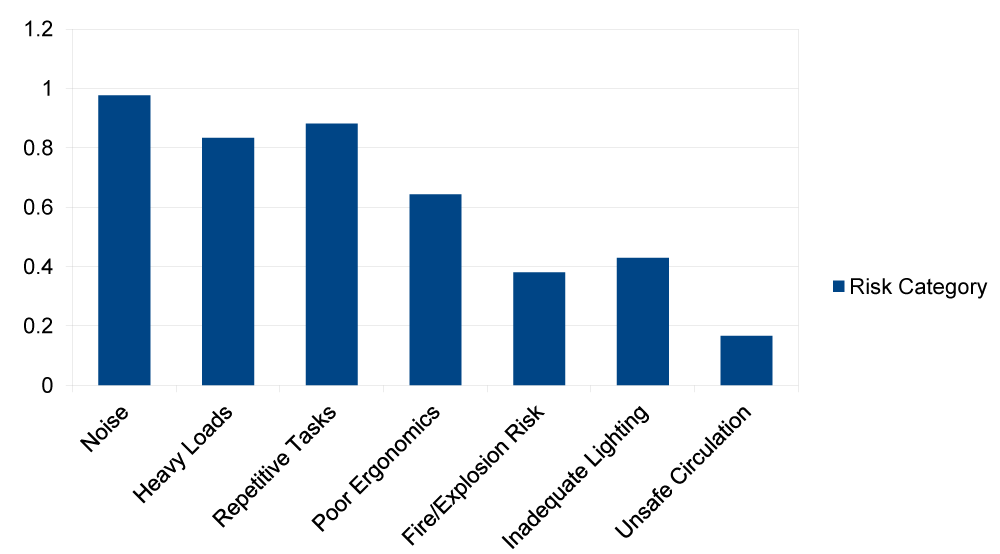More Information
Submitted: May 29, 2025 | Approved: June 10, 2025 | Published: June 11, 2025
How to cite this article: Diouf A. Occupational Risk Assessment in a Woodworking Workshop: A Case Study. Arch Case Rep. 2025; 9(6): 186-187. Available from:
https://dx.doi.org/10.29328/journal.acr.1001143
DOI: 10.29328/journal.acr.1001143
Copyright license: © 2025 Diouf A. This is an open access article distributed under the Creative Commons Attribution License, which permits unrestricted use, distribution, and reproduction in any medium, provided the original work is properly cited.
Keywords: Occupational health; Woodworking industry; Risk assessment; Noise exposure; Fire hazards; Hearing loss; Workplace safety
Occupational Risk Assessment in a Woodworking Workshop: A Case Study
Abdoulaye Diouf*
Statistical and Decision Computing Engineer, Web Developer, Senegal
*Address for Correspondence: Abdoulaye Diouf, Statistical and Decision Computing Engineer, Web Developer, Senegal, Email: [email protected]
This article presents the findings of an occupational risk assessment conducted in a woodworking workshop in Senegal. Using a structured questionnaire administered to 42 workers, this study identified major exposure factors related to physical, biological, ergonomic, and safety risks. Key issues included exposure to noise, manual handling of heavy loads, repetitive tasks, and limited ergonomic design. Audiometric testing was conducted on selected workers to assess the impact of noise exposure. Health risks such as hearing loss, fatigue, respiratory issues, and musculoskeletal disorders were noted. Additionally, one third of the respondents reported a perceived risk of fire or explosion, potentially due to the accumulation of wood dust and flammable materials, as well as inadequate maintenance of equipment. These results support the urgent need for preventive actions to improve worker safety and well-being in artisanal workshops.
Occupational health remains a major challenge in the informal and artisanal sectors, particularly in woodworking, where workers are exposed to multiple risks daily. The purpose of this study is to assess the prevalence and nature of occupational risks in a Senegalese carpentry workshop, based on workers’ self-reported experiences and exposures.
The study used a cross-sectional design and was based on a questionnaire distributed to 42 employees working in a woodworking workshop. Variables covered include sociodemographic information, exposure to physical, chemical, ergonomic, and psychosocial risks, and self-reported health outcomes. Quantitative variables were analyzed using measures of central tendency and dispersion, while qualitative variables were described with frequency tables and charts. Audiometric tests were also conducted on a subset of workers to evaluate the impact of continuous noise exposure (Table 1, Graph 1).
| Table 1: Summary of Reported Risks and Exposures. | |
| Risk Category | % of Workers Affected |
| Noise | 97.6% |
| Heavy Loads | 83.3% |
| Repetitive Tasks | 88.1% |
| Poor Ergonomics | 64.3% |
| Fire/Explosion Risk | 38.1% |
| Inadequate Lighting | 42.9% |
| Unsafe Circulation | 16.7% |
Graph 1: Distribution of Perceived Risks among Workers.
Key findings include:
- 97.6% reported being disturbed by ambient noise.
- 83.3% were exposed to the manual handling of heavy loads.
- 88.1% performed repetitive tasks daily.
- 64.3% considered their workstations not ergonomically adequate.
- 38.1% perceived a risk of explosion or fire, likely due to poor ventilation, accumulation of wood dust, and the presence of flammable materials.
- Only 42.9% found lighting adequate for their tasks.
- Several workers (16.7%) felt that circulation areas were dangerous.
The results confirm a high level of exposure to physical and ergonomic risks among carpenters. These findings are consistent with international studies highlighting the vulnerability of informal sector workers. The noise exposure rate (97.6%) and the lack of ergonomic conditions call for urgent ergonomic restructuring and health monitoring. The audiometric tests indicated early signs of hearing impairment in workers exposed to high noise levels. Furthermore, perceived fire risk appears to be rooted in actual workplace conditions—wood dust, solvent use, and lack of safety procedures—which require attention [1,2].
Although chemical and biological risks appeared less reported, the combination of exposures requires holistic risk management.
This study sheds light on occupational health challenges in the woodworking sector in Senegal. Improving safety standards, ergonomics, and awareness among workers can contribute to reducing risk exposure and promoting a healthier work environment. Further studies could expand the sample and integrate direct workplace measurements and medical monitoring to complement self-reported data.
